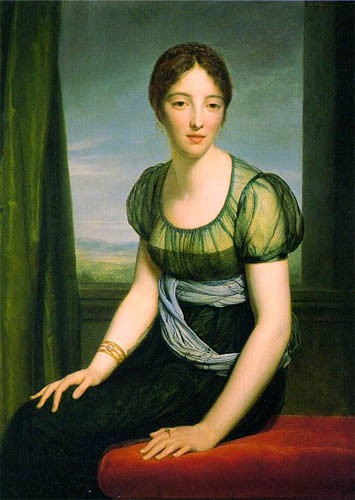At the very end of the 18th century, Gérard put to one side history painting and executed some remarkably beautiful portraits. Indeed, he became famous through his portraiture, and it was to this that he owed his appointment as official portrait painter to Napoleon, the imperial family and the great dignitaries of the Empire. After renditions such as The Painter Isabey and his daughter and Larévellière-Lépeaux, Gérard took as his model the sensuous wife of Regnaud de Saint-Jean d'Angély, Augustine-Françoise-Eléonore de Guesnon de Bonneuil, known as Laure de Bonneuil.
After her marriage in 1795, Mme Regnaud soon became one of the most fashionable women of the Directory period. She was universally reknowned for her beauty and culture, and her salon was one of the most brilliant of the Consulate and Empire periods.
But as is often the case with women who are rather too beautiful, Laure ruffled feathers. Rumours attributed to her many lovers, although most of this tittle tattle was propagated by chief of police Fouché in his attempts to damage politically her husband, the latter a devoted servant of the emperor. Napoleon however as a result distrusted her and distanced her from the imperial court. She was too attractive, too free in her ways and seemed too connected with the opponents of the regime. Although suspected of conniving with royalists, she was nevertheless an ardent supporter of the Empire when it was threatened, and bore no grudge for the ostracism to which she had been subjected. During the Restoration, her house became a cengtre for Bonapartist shrine. Arrested in 1817, held in the Conciergerie, and later compelled into exile in Belgium, the Comtesse Regnaud de Saint-Jean d'Angély was a faithful bearer of the Napoleonic torch. She had the pleasure of seeing the re-establishment of the empire before dying in 1857.
This portrait of Mme Regnaud was exhibited for the first time at the Salon of 1799 and was a great success. Praised by critics, the work is (as contemporary commentators noted) a perfect likeness of the model. There is no affectation or preciosity here; only the intention to render the purity of the lines of a women universally lauded for her 'antique' beauty. For the perfect grace of the pose, the delicate colouring, and the elegance of the silhouette set against hazy landscape, Gérard took his inspiration from the portraits of the Italian Renaissance in this his version of a charming and gentle young woman, yet so sensuously curvacious. With it, he paved the way for the Florentine paintings of Ingres.
Karine Huguenaud (tr. P.H.)
November 2002
The Comtesse Regnaud de Saint-Jean d’Angély
Artist(s) : GERARD François (baron)

- Date :
- 1798
- Technique :
- oil on wood
- Dimensions :
- H = 1.025 m, L = 0.74 m
- Place held :
- Paris, Musée du Louvre
- Photo credit :
- © CGFA

